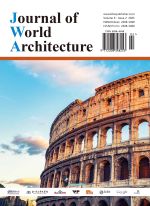A Holistic Approach to Architecture A Case Study: Music Center and Library, Tel-Aviv
Abstract
The aim of this article is to present a unique interpretation of the holistic worldview, both in theory and in practice. It explores how this approach, along with a planning process fundamentally different from conventional methods, was implemented in the design and construction of the Music Center and Library in the city of Tel Aviv. This process forms a coherent representation of a complete worldview: a humanistic, holistic worldview developed and adopted through more than five decades of architectural practice across all scales of design. In this approach, a building is not regarded as a collection of isolated design elements, but as one hierarchical language, in which the building, its interior, and its ornamented details down to the handle of the door is one continuous system. Within this system, the building, its interior spaces, and even the smallest ornamental details, down to the door handles, are conceived as parts of a single, continuous whole. This worldview aligns with contemporary scientific discourse in fields such as cosmology, neurobiology, psychology, complexity theory, and Buddhist philosophy, disciplines with which this body of work is closely associated.
References
Alexander C, 1979, The Timeless Way of Building. Oxford University Press, New York.
Garbow S, Alexander C, 1983, The Search for a New Paradigm in Architecture. Oriel Press, Boston.
Yanagi S, 1976, The Unknown Craftsman. Kodansha International Ltd, Tokyo.
Alexander C, 2002–2004, The Nature of Order. Center for Environmental Studies, Berkeley.
Alexander C, Ishikawa S, Silverstein M, 1977, A Pattern Language. Oxford University Press, New York.
Portugali N, 2006, The Act of Creation and the Spirit of a Place: A Holistic-Phenomenological Approach to Architecture. Edition Axel Menges, Stuttgart.
Herrigel E, 1964, Zen in the Art of Archery. McGraw-Hill Book Company, New York.
Dalai Lama (His Holiness the), 1997, The Joy of Living and Dying in Peace. Harper Collins, India.

